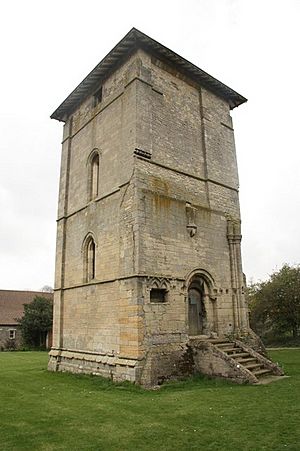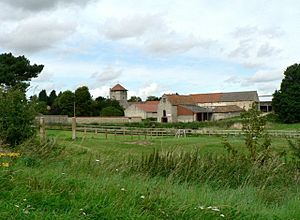Temple Bruer Preceptory facts for kids
Quick facts for kids Temple Bruer Preceptory |
|
|---|---|

Temple Bruer Preceptory
|
|
| Location | The Preceptory is sited in the farmyard of the former Temple Bruer Farm |
| OS grid reference | TF0085153709 |
| Founded | c1150 |
| Demolished | After 1536 |
| Architectural style(s) | Early English architecture |
|
Listed Building – Grade I
|
|
| Designated | 1 February 1967 |
| Reference no. | 485917 |
| Designated | 13-Dec-1929 |
| Reference no. | 1007686 |
| Lua error in Module:Location_map at line 420: attempt to index field 'wikibase' (a nil value). | |
Temple Bruer Preceptory is an old building in Lincolnshire, England. It's one of the few places where you can still see ruins of the Knights Templar in England. The name "Bruer" comes from an old French word for "heather," because it was in the middle of a heath (a wild, open area).
The Knights Templar built this site between 1150 and 1160. They were a famous group of Christian knights during the Middle Ages. The order was later closed down in 1312. You can find the Preceptory about 2.5 miles (4 km) north of Cranwell. People have dug up the site twice to learn more about it, first in 1832-33 and again in 1908.
Contents
Who Built Temple Bruer?
The Temple Bruer Preceptory was started in the late 1100s, when King Henry II was ruling. A man named William of Ashby de la Launde helped by giving land. He later joined the Preceptory, which is like a local headquarters for the Knights Templar. Other important people also gave land and money to help the Preceptory grow.
This place became quite large and important. In 1306, the knights were even allowed to add battlements (strong walls with openings for defense) to their main gate. This was called a "licence to crenellate."
The End of the Knights Templar
The Knights Templar order faced problems in France. Soon, King Edward II in England also took action. In 1308, he sent knights to arrest the Templars at Temple Bruer. This included William de More, who was a leader of the order in England. They were held in Lincoln and then sent to the Tower of London.
In 1312, the Pope officially closed down the Knights Templar. Their properties, including Temple Bruer, were supposed to be given to another group of knights called the Knights Hospitaller. It took many years, until the 1330s, for the Hospitallers to finally get control of the lands from the English King.
Later, in the 1530s, a knight named Sir Giles Russell was in charge of Temple Bruer. He found the buildings were falling apart and tried to fix them. However, he was often away, and the Preceptory was eventually closed down completely in 1541.
What Lands Did the Preceptory Own?
The Temple Bruer Preceptory originally received land in places like Ashby de la Launde and Rowston. They also owned churches and areas for sheep to graze. In 1338, the Preceptory earned a good amount of money from its lands and churches.
Historians have also found that a "Deserted Medieval Village" once existed south of the Preceptory. This means there was a village there in the Middle Ages that people later left. Pictures from above show it might have been a walled area with a gate.
What Remains Today?
Today, the most important ruin you can see is the tall, square south tower of the old church. This tower was one of two added to the church when the Templars owned it. The tower is now looked after by Heritage Lincolnshire.
Next to the tower, there's a farmhouse built in the 1840s. It was likely designed by an architect named William Adams Nicholson.
Digging Up the Past: Excavations
1833 Dig
In 1833, a man named Rev. Dr. Oliver was allowed to dig at the site. He wrote about his discoveries, but later digs showed that he might have misunderstood some of what he found. For example, he thought some passages were secret tunnels, but they were actually a crypt (an underground room). He also thought a "horrible cavern" was something mysterious, but it was just an old oven!
1908 Dig
In 1908, a famous archaeologist named William St John Hope led a much bigger dig. He was very careful and helped us understand the Preceptory much better.
Hope found parts of the old wall that surrounded the area. He also found traces of smaller buildings, like a chicken coop and stables. A larger building, probably a barn, was found south of the church.
Hope discovered that the Preceptory was built in four main stages:
- Phase 1: The first church had a round main area, about 15 meters wide. It had a circle of eight columns inside. To the east was a rectangular area called a presbytery (the part of the church where the altar is). Below this was a crypt. This first part was built in the mid-1100s.
- Phase 2: In the late 1100s, a porch was added at the west end. The presbytery was also made longer.
- Phase 3: Later, towers were added on both sides of the presbytery. The northern tower is gone, but the southern tower is still standing tall today. Inside the standing tower, you can see where the roof used to be and where the altar was. There's also a special stone bench with seats for priests, called a sedilia, and a piscina for washing sacred vessels. A spiral staircase leads to a room above.
- Phase 4: The final addition was a chapel on the south side, which is now just foundations. You can still see where its roof joined the standing tower.
Gallery










